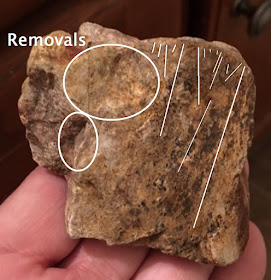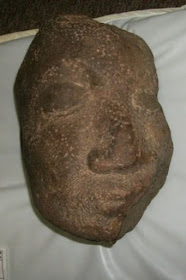
'Mammoth icon facing left with human face profile on its posterior facing right'
Ken Johnston find at Whetstone Park, Columbus, Franklin County, Ohio
Side 2 of the flint also exhibits the North American Paleolithic art motif of a mammoth form with a human face form on its rear. This motif has been described in many examples on this blog from a life-size carved mammoth on a rock outcrop in Virginia to smaller pieces like this one at 4cm. I have described it from Licking County, Ohio, about 40 miles east of the location of this find. The typical mammoth head dome and the trunk curvature are captured in views on both sides.
Here the human is facing left, mammoth facing right, the opposite of the direction of side one. So, the human face profile here has mammoth head dome and trunk line on the other side, and mammoth facing right has a human on its other side. There is some worked human eye detail on this side. This is a flint art object made of exotic chert material originating about 150 miles distance near Carter Caves, Kentucky (more below). I do not think it was a tool.
Both sides with illustrations of the interpreted two human facial profiles and the two mammoth profiles on this one flint.
Here, I illustrate subtle but very intentional representations of two additional creatures on this flint. They are in line with other figure stones described on this blog. On one side is a 'horse head' sandwiched between the human and the mammoth trunk with an eye divot in the flint made at the correct spot. The other side has a 'feline face' with two eyes, a nose bridge and a distinct feline mouth. The combination of two humans, two mammoths, a horse and a feline make this an extraordinary polymorphic art work with likely great symbolic significance to its maker.
This is a small mammoth representation to the right of the feline face which was made by a precise removal to create a 'trunk' and a divot to create the 'eye' of the little mammoth. Click photos to expand and toggle. If one looks at it on the photo marked 'feline face' it has flaring ears like an elephant charging (a lion). This is a an animal behavioral activity captured by a human in the permanence of stone.
A aerial view of Whetstone Park in Franklin County, Columbus, Ohio. The Olentangy River is seen on the left (Olentangy R.->Scioto R. ->Ohio R.). The fields to the right of the river are the east flood plain. To the right of the 'red dot' is a rise of 40 feet. The slope to this rise was eroding these artifacts. The main Columbus north-south drag, High Street, may be seen at the upper right corner. The site was fully glaciated in the Wisconsinan and it is thought to have reached its final maximum at 18,000 years ago and then started its retreat north.
The mammoth/human combination flint is made of stone material called Carter Cave Chert. The route on the map goes across the Ohio River and follows the Scioto River to Columbus and then up the Olentangy River to the Clintonville neighborhood's Whetstone Park. The chert material is considered "exotic" because of the distance from its find location to its source. Carter Cave material is rarely found north of Columbus.
Columbus, Ohio Levallois-like artifact. The core preparation evidenced here has been described as "preferential unidirectional-convergent."
Lyn's daughter Brennah and I have been picking up rocks and artifacts for the last 8 of her 13 years. A few weeks back I showed her what Levallois-like prepared core technology artifacts look like and told her to be on the look out for them. Within a couple of minutes of me saying we were on top of artifacts while on our walk at Whetstone's Park Of Roses yesterday she produced this possible example and several other crude coarse stone artifacts.
Mostly coarse stone tools. Artifacts identified on a family Sunday walk. The one at lower left is a simple broken pebble, either a core to generate another tool or tools or a desired end product itself- a rounded stone with a sharp edge. The mammoth/human combination flint is pictured at lower right. I thought it was likely a tool until I got home and took a closer at it. Now, I think it is portable rock art.
All of these items were found eroding from a slope in 5 minutes time in about a 9 square meter space. Thanks Brennah!


















































